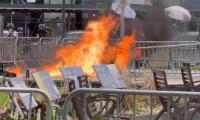Brute force and coercion always work. It’s just science. But like all science, there is a footnote to such force and coercion. It works for a limited amount of time, on a limited amount of people. This is where the art of force and coercion comes in. The art is knowing when force and coercion are not working any longer, who they will never work on, and what the consequences of continuing to use force and coercion will be.
In short, brute force and coercion are a viable and useful tactic – but they cannot be a strategy. If the only thing you have going for you is force and coercion, you are already in a lot of trouble.
The brute need not be an artist to be able to coerce individuals, firms, and institutions to her or his will once, twice or three times. But to ensure that her or his will is adhered to for a long period of time, the brute must be an artist. In short, you cannot, ever, sustain brute force and coercion as the only weapon in your arsenal.
In the war on terror Pakistan fought from 2007 onwards, Pakistan itself began as the shy and reluctant artist. “They are our brothers”. “We must talk to them”. “We must address their legitimate concerns”. Some of this was spot on. Some of it was misguided. Some of it was plain cowardice.
When the dust settled, Pakistan had caught on to the science too. Of course, talk we did. But address legitimate concerns we did not (the TTP didn’t have any). And as for the notion of fraternity. Well, all of humanity is a sisterhood or brotherhood. But helplessly allowing others to poison and destroy this brotherhood – out of a false sense of pacifism – is neither brave nor smart. So force and coercion was finally applied. Pakistan fought. And won.
The turning point in the war on terror was finally figuring out that the TTP, like all groups that have specific political objectives, had some people that could be talked to, and some people that would just plain give up and flee, and some people that could neither be reasoned with or bought off, nor would they give up and leave for the greener pastures of protection being offered to them by enemy powers in foreign countries. That last group of people needed a Pakistan that was capable of brute force and coercion – enter army aviation, IB, CTD, SSG, infantry, artillery and an array of other instruments of force. The other two groups needed negotiators, bureaucrats, religious leaders and politicians. The first group was small, and needed to be taken out. The overwhelming majority did not. They needed conversations, compromise and cash. War or peace, that’s kind of how the world works.
From the petrol crisis, to the PIA fiasco, to a feuding cabinet, to a universities funding crisis, to India’s incessant sabre-rattling and war mongering, to the still very real Covid-19 crisis, Pakistan is struggling mightily today. This is not one but several burning platforms. It seems that all the King’s Men can do is spit contemptuously at the raging forest fire of misgovernance that consumes the country in the hope that this will extinguish it.
Who is the King? For the simpleton, this is easy. But heroes and villains don’t come in clean-cut boxes of zeroes and ones with labels. The biggest and easiest of the binaries is civ-mil. But there are others, all equally simplistic. Imran Khan versus everyone. Nawaz and Maryam versus all. Bilawal Bhutto Zardari versus all. Pakhtuns versus Punjabis. Urdu versus all languages. Justice Qazi Faez Isa versus all. Over and over and over again, the idiocy of the binary is exposed because it pits your specific pin up hero against everyone else. Marvel Comics have thicker plots than this foolishness.
In reality, the King is the state. The King’s men is the state apparatus. And all the Kings’ men are having a whale of a time even understanding where all the pieces of Humpty Dumpty are. So instead of search parties and Samad Bond, they default to brute force and coercion. Let’s consider the wisdom of this approach.
The 1974 reforms to the country’s public administrative system were designed for a country of 65 million. In 1988, Pakistan crossed the 100 million mark. In 2016, it crossed 200 million. In July 2020, we lament misgovernance, despite knowing that this system was made in 1974, by people whose expertise was based on administering the country in the 1940s, 50s and 60s. Why, then, does everything seem like it is falling apart? Because it is.
As September 2014 rolled around, Nawaz Sharif was at a complete loss. How could his dream tenure be soured so quickly and so unfairly? He never recovered from the dharna’s poisoning of his tenure. His daughter, his brother, Ishaq Dar and Fawad Hassan Fawad held his tenure together with masking tape and staples from late 2014 to April 2016, but when the Panama Papers hit, the bottom fell out. Notwithstanding the clearly unfair treatment of his case in both the courts of public opinion and the Supreme Court itself – a besieged Sharif committed blunder upon blunder in a game room that was designed to manufacture failure. Throughout his tenure, however, he enjoyed one clear advantage (as did President Asif Ali Zardari throughout his). A grand consensus on the rules of the game, or the Charter of Democracy, in full effect. Even though two prime ministers were deposed via the courts between 2008 and 2018, this grand consensus held for an entire decade.
PM Khan’s most ardent, effective and powerful supporters believed that the collapse of this consensus would be a great success, and the big secret that will help unravel the scourge of corruption in public life. This belief was deeply problematic for two reasons. First, fiduciary malfeasance or 'corruption' are not primary or even secondary factors in keeping nations from economic or militarily advancement. They just aren’t. Second, the purpose of the Charter of Democracy was not to protect the corrupt. It was to protect elected governments.
So what happens when you take such a deeply problematic worldview – and somehow its most ardent advocate becomes prime minister? Exactly what is happening to Pakistan today. A dysfunctional cabinet and PMO. Five chairpersons at the FBR, nine major railways accidents, four chairpersons at the BOI, the near collapse of the aviation sector, numerous transfers of IGs, chief secretaries, and other key officers around the country. The icing on the cake? PM Khan has not been able to tackle corruption, including in his own government. And the cherry on top? PM Khan does not enjoy the canopy of protection that the Charter of Democracy was designed to offer to elected governments. Perhaps most egregiously he is hostage to many of the same unscrupulous politicians for whom he had such choice pejoratives throughout the era of innocence amongst PTI supporters.
As the curtains come down on this era of innocence, there needs to be some realization among PM Khan’s backers that the science on force and coercion has already run out. The management of Pakistan in these dire times of disease and death via the Covid-19 virus, and the constant threat of war via India, requires an artists’ deft touch, not the scientists’ brute force.
Public opinion cannot be clubbed into submission ad infinitum. The very instincts that were deployed for many years to talk to the TTP, wrongly, must now be re-deployed, rightly and righteously. Pakistanis have to put away their guns and their anger at each other. They must roll up their sleeves and sit down and talk. For 24 years, we have heard the legend of the Kaptaan leading from the front. Pakistan is one team. One nation. It requires leadership capable of leading all of us, not just those vulnerable to the allure of fairy tales. It is not too late, yet.
The writer is an analyst and commentator.







